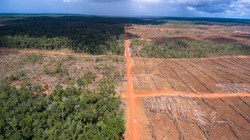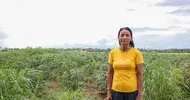20 August 2019
Mega-plantations in Southeast Asia: Landscapes of displacement
Mega-plantations in Southeast Asia: Landscapes of displacement
Author: Miles Kenney-Lazar and Noboru Ishikawa
This article reviews a wide body of literature on the emergence and expansion of agro-industrial, monoculture plantations across Southeast Asia through the lens of mega projects. Following the characterization of mega projects as displacement, we define mega-plantations as plantation development that rapidly and radically transforms landscapes in ways that displace and replace preexisting human and nonhuman communities.
Mega-plantations require the application of large amounts of capital and political power and the transnational organization of labor, capital, and material. They emerged in Southeast Asia under European colonialism in the nineteenth century and have expanded again since the 1980s at an unprecedented scale and scope to feed global appetites for agro-industrial commodities such as palm oil and rubber.
While they have been contested by customary land users, smallholders, civil society organizations, and even government regulators, their displacement and transformation of Southeast Asia’s rural landscapes will likely endure for quite some time.
Mega-plantations require the application of large amounts of capital and political power and the transnational organization of labor, capital, and material. They emerged in Southeast Asia under European colonialism in the nineteenth century and have expanded again since the 1980s at an unprecedented scale and scope to feed global appetites for agro-industrial commodities such as palm oil and rubber.
While they have been contested by customary land users, smallholders, civil society organizations, and even government regulators, their displacement and transformation of Southeast Asia’s rural landscapes will likely endure for quite some time.
Agro-industrial plantations have expanded across Southeast Asia since the colonial era, transforming vast swaths of rural landscapes into what Li (2018) has referred to as “plantation zones,” playing a critical role in the progression of the Plantationocene in the region. Here, we conceptualize such plantation expansion through the lens of megaprojects—complex, expensive developments that have signifi cant impacts on the economy, environment, and society through their creative destruction, radically displacing and transforming landscapes.
They are developed through massive applications of state power and capital. Applied to the plantation sector, mega-plantations radically transform rural landscapes, displacing previously existing peasant communities and rural environments and producing in their place new landscapes of monoculture and mono-crop plantations, networks of road and electric infrastructure, processing facilities, and labor camps. Such transformations do not arise solely from the development of large-scale estate plantations with large plot sizes that constitute a megaproject in and of themselves. Mega-plantations are also produced when a complex array of plantation developments cohere in a particular landscape or region, which when combined lead to the same types of landscape transformations or at an even larger scale than single projects.
Thus, mega-plantations develop through both rapid, intentional projects and a more spontaneous aggregation of smaller projects. In this article, we do not set a strict quantitative defi nition concerning what precisely constitutes a mega-plantation, as we believe they are better defi ned by qualitative parameters describing them as both a process and a particular type of landscape transformation.
They are developed through massive applications of state power and capital. Applied to the plantation sector, mega-plantations radically transform rural landscapes, displacing previously existing peasant communities and rural environments and producing in their place new landscapes of monoculture and mono-crop plantations, networks of road and electric infrastructure, processing facilities, and labor camps. Such transformations do not arise solely from the development of large-scale estate plantations with large plot sizes that constitute a megaproject in and of themselves. Mega-plantations are also produced when a complex array of plantation developments cohere in a particular landscape or region, which when combined lead to the same types of landscape transformations or at an even larger scale than single projects.
Thus, mega-plantations develop through both rapid, intentional projects and a more spontaneous aggregation of smaller projects. In this article, we do not set a strict quantitative defi nition concerning what precisely constitutes a mega-plantation, as we believe they are better defi ned by qualitative parameters describing them as both a process and a particular type of landscape transformation.
Download the full paper here: http://laofab.org/document/view/3994













